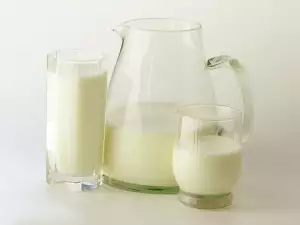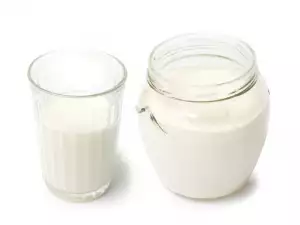Milk is a biological nutritious liquid produced in the mammary glands of mammals. Unique in its own right, milk is the only product that nature has created solely for feeding young offspring. Generally speaking, milk comes from humans (breast milk) or animals - cow milk, sheep milk, goat milk and buffalo milk being the most common.
Milk has been used as a food source, medicine and even as a beauty treatment by humans for ages. With the development of industry, the population's growing needs and the use of various substances that stimulate greater milk production in animals, many questions arise as to the quality of the milk.
Numerous points of evidence, related to the way the animals are cared for, the antibiotic foods they are fed and so on, indicate that ultimately the majority of the milk offered in stores is not the same wholesome and healthy food that our forebears once consumed. And what's more - store milk is loaded with dangerous hormones. These shocking data are valid to a great degree for milk production in the US but also in many developed nations as well.

Usually, milk that we buy from supermarkets is enhanced by the method of pasteurization, the mass model for solving the problem with diseases. This model, developed by the French scientist Louis Pasteur, requires heating the milk briefly to 170°F (75°C) or more, to kill the bacteria but retain the taste qualities. It's important to note that pasteurization is not a 100% surefire way for getting rid of potentially dangerous bacteria.
That can only be guaranteed by repeated pasteurization, which companies do not use because it is not profitable. Additionally, pasteurization, along with harmful bacteria, also eliminates those that facilitate milk's absorption and the gut flora that aid in breaking down and absorbing food.
Composition of Milk
Milk is considered one of the most complete foods known to man. It contains a balance of dietary fats (saturated fatty acids, lecithin, choline), carbohydrates (lactose), proteins (2/3 casein, 1/3 lactoglobulin and lactalbumin), vitamins (А, В6, B2, РР, carotene), salts (Ca, Mg, P, Na, Cl), i.e. all substances needed for the growth and development of the human body, and in the right quantities on top of it all.
Dry matter composes 11-17% of milk, while the rest is water. Milk is an important source of water- and fat-soluble vitamins for suckling animals, children and adults. About 4 1/5 cups (1 L) of cow's milk are capable of satisfying the daily vitamin needs of humans.
In milk there are quantities of vitamins A, B, C, D, E, F, metal ions and ion complexes such as K+, Na+, Ca2+, Cl-, COO-, HPO32-, micronutrients such as I-, Fe2+, Fe3+, Co2+, Zn2+, Ni2+, nitrogen and carbon dioxide.
Calcium and phosphate salts are also found in milk. They aid in the formation of bone tissue, restoring blood, lymph and brain function. Numerous other chemical elements are also found, including potassium, sodium, magnesium, chlorine, zinc, cobalt, copper, iron, manganese, iodine and others. Vitamin B12 is especially valued.

Choosing and Storing Milk
The first rule when choosing milk is to check the date of expiration. Choose milk from the coldest part of the refrigerators in stores and then store it in the coldest part of your own fridge as well. Sometimes, during high temperatures, inadequately processed milks curdle in 10 min. - from the time you buy them to the time you get home.
Milk absorbs other smells quite well, so you need to close the cap tightly when returning it to the fridge. We're used to usually keeping it in the door of the refrigerator but this is improper - the constant opening and closing of the door exposes the milk to heat more often.
Glass and acid-free plastic food storage containers are the most suitable for storing milk because metals oxidize the vitamins and bind to some of the salts. When the temperature exceeds 210°F (100 °C), irreversible changes occur in the structure of the milk and it not only loses its beneficial but gains harmful properties. When the milk is boiled again, the casein molecule, the main protein of milk, is broken down into small components. They have a carcinogenic (cancer causing) and toxic effect.
When boiling milk, do so in a water bath or in a special milk boiler, so that the temperature does not exceed 210°F (100 °C). Once you boil the milk once, store it in the fridge and only reheat it to 130°F (55 °C) before drinking. It is best to consume it as soon as possible, at the peak of its freshness - within 2 days. Oxidation processes occur with each passing minute and bacteria grow, depriving it of its valuable components and properties.
Culinary Use of Milk
Milk belongs to 1 of the main food groups. There is hardly a dish that can't be prepared with milk added to it. Its use in pastries, cake layers, sweet creams, as part of a topping for moussaka and different oven bakes is pretty common.

The one-of-a-kind Bechamel sauce just wouldn't have the same taste if not for milk. Fish and other meats can be soaked in milk before being cooked further. You can prepare chicken with milk, as well as with other meats and be sure that the taste will impress both you and your guests/family.
Whether you prepare a pudding for a biscuit cake or simply serve your morning breakfast of muesli, cornflakes and oatmeal with milk, you can be sure that you'll end up with a wholesome and nutritious food.
Benefits of Milk
Even Hippocrates was familiar with the benefits of milk. He cured a number of patients from tuberculosis using goat's milk. Avicenna was also convinced that goat's milk maintained health and clarity of mind.
Vitamin K contained in cow's milk maintains bone health, providing us 12.2% of our daily recommended values of the vitamin. Vitamin D, on the other hand, helps manage the right levels of calcium in the blood. As well, it is rich in vitamin A. When our vitamin A levels are low, we are susceptible to infections, including ear problems, frequent colds and so on. By drinking 1 cup of cow's milk per day, we assure 10% of our daily values of vitamin A.
Dairy foods are better than food additives containing calcium when it comes to healthy bones in girls. A study done with girls undergoing puberty, whose bones are subjected to the stress of growth spurts, has shown that consuming dairy foods is much more effective than taking supplements containing calcium. Milk is an excellent source of proteins and vitamin B, which takes care of our cardiovascular health.
Dangers of Milk
The majority of the milk nowadays comes from animals injected with hormones to stimulate milk production. The animals are fed for commercial purposes, with foods that may include hay, grain, cardboard, wood chips, they are regularly injected with antibiotics.
Thanks to genetic engineering in milk cows, milk production is increased from 15-25%. This is good for farmers but bad for the animals, which become more vulnerable to infections. These infections are treated with large amounts of antibiotics, which later seep into the milk.
It has been found that tuberculosis and other diseases are easily transmitted through breast milk and milk. Many of these diseases are also transmitted through regular consumption of milk, among them plagues such as hepatitis.
One particular danger is the transfer of viruses and immunoglobulins between species, in other words - between cows and humans. There is no genuine proof that milk from cows stimulates the human immune system.

In contrast, bacteria and viruses are easily transmitted from cows, not to mention the other main problem: genetic engineering and the growth hormone used to increase milk production and whose waste ends up in the milk.
Another possible problem is the absorption of milk by the body, because with age our bodies lose the ability to produce crucial enzymes, such as lactase for example. Unlike many other enzymes, these are not renewed when the need arises. At least about 20% of humanity loses its ability to make this enzyme with age.
Frequent consumption of milk is not recommended for people who are lactose intolerant. Even though the body's ability to process lactose is not completely stopped, it is very limited. Such people may experience nausea, diarrhea, and in rare cases even allergic reactions. The lactose from milk can be removed but this process is expensive and rarely used. Relating to the problem of absorption, when milk is affected by stomach acids, it curdles and absorption is slowed further.
Beauty Care with Milk
We've all heard that the legendary Egyptian pharaoh Cleopatra maintained her beauty by taking baths in milk. For ages, people have known that milk is an excellent way of maintaining healthy and beautiful skin, there are even data indicating it as an effective fat burner. Milk contains bio proteins, a popular means of maintaining hair shine. Blond hair especially can take advantage of this fact. Here are several tried and true masks for shiny and healthy hair and skin.
Milk for blond hair

First, wash your hair with specially made shampoo for blond hair, rinse it well with cool water, then rub it with this mixture: 3 tbsp milk, 1/2 cup chamomile extract, 1/2 cup elder extract and 6 drops of apple cinder vinegar. Let it work for 10 min. and rinse.
Mask with milk for oily skin
Milk can help close pores, relax and cleanse oily facial skin. Make a mask of 1 tbsp freshly mashed skimmed cheese (or cottage cheese), 1 tsp honey, the juice of 1/2 a lemon and 2 tsp milk. Beat everything well and smear thoroughly on the face, having washed it beforehand. Leave it for 10 min. and rinse with cool water.
Milk for dry skin
Regular cleansing with milk helps get rid of dry skin. It is recommended to smear whole milk on the skin, leaving it to dry on it. After it does, take a shower to rinse the skin.



















